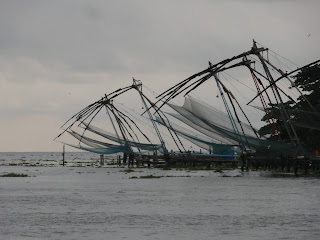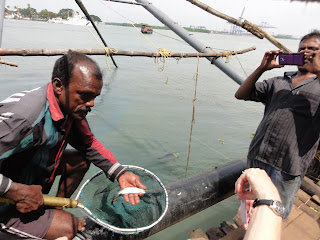On Saturday, October 31st, we got up early to take one of Sudha's walks. We walked a block west to the car ferry to Vypeen Island, straight across the river. When we got to the island, Sudha discovered that a bus wasn't running as expected, so he flagged down three tiny taxis (like a four-wheeled tuk-tuk, but fully enclosed and much higher-powered), and soon we were dropped off near a bridge at the other side of the island. From there we walked a short way and found ourselves at the place where fisherman unloaded and sold their wares. There was a fish auction going on, and meanwhile we saw huge numbers of shrimp, as well as crabs, anchovies, sardines, mackerel, etc. We went onto one of the boats, which had its nets neatly rolled up on the deck. They were hoisting small containers of fish, mixed with shaved ice, out of the hold. Then they washed the ice out and brought the fish ashore. The price there must have been right, otherwise they would have gone somewhere else to sell.
We caught tuk-tuks back to the ferry dock, took a passenger ferry back to the Fort Cochin side, and went to our hotel for breakfast.
Later we visited a compound where Brahmin families lived, because the local Maharaja had brought them from Tamil Nadu to cook for a nearby temple, for the temple in his palace and for his own table, when he was in residence in Kochi. Nowadays, they have other jobs, but these ten families still have a hereditary right to live in the compound. They can rent their apartments out, but they can't sell them. These residences are small and simple.
Then we walked a couple of blocks to the so-called Dutch Palace. The palace was actually built by the Portuguese for the Maharaja, but after the Portuguese were kicked out, the Dutch restored the building. There were some interesting murals relating to the Ramayana and to the origination of creation in the sleeping Vishnu. There were exhibits relating to the local royal family including pictures showing the evolution of dress, from bare-chested men and women, the former wearing loincloths and the latter wearing dhotis.
Then we went to the Indian Heritage store, where more was added to the U.S. trade deficit.
As we neared our hotel, Sudha noticed that the famous Chinese nets were in operation, so he rushed us over there. and got the women in our group pulling on the ropes to get the nets up out of the water. They only caught a handful of small fish.
We had a very nice lunch at the Cochin Club, then walked across the street to St. Francis Church, where we saw the ex-tomb of Vasco da Gama, who died in Kochi some years after discovering the route around the Cape of Good Hope to India. He was buried in this church, but the tomb is now empty, since his body was eventually taken back to Lisbon. Sudha pointed out the sweep fans along the length of the church, installed by the Dutch and operated in the old days by punkah wallahs pulling on ropes through the side walls.
The women then all went down the street to the Fabindia fabric shop, while we men walked back to the hotel.
Later, housekeeping staff helped the women all put on saris, while Sudha showed the men how to wear a dhoti. A lot of laughter and a lot of pictures.
In the evening, the group divided in two, the two couples in one taxi and the five individual women in another. Our taxi drove about three miles to the nice seven-year-old middle-class home of Albert, a tour guide colleague of Sudha, and his wife, Jasmine, a fourth-grade teacher. Albert greeted us at the cab with an umbrella (we arrived in a thunderstorm), and after introducing us to Jasmine, disappeared for the rest of the evening. We had a pleasant conversation with Jasmine in their living room, overlooked by the standard house shrine, except that, unlike the Hindu shrine we had seen in a Brahmin dwelling that morning, this centered on a picture of the Sacred Heart of Jesus.
Jasmine led us into the dining room and fed us very well, with a rice pancake in sweet coconut milk, then, a piece of curried tuna, then a cabbage dish, then rice with a thin yogurt sauce, with a large green and a small yellow banana for dessert. She herself didn't eat (which Sudha had said was normal for Indian women hosting meals}.
Sudha had also said that visits to Indian homes begin with conversation and end with dinner, so that when we had eaten, we talked a little, and then said our goodbyes. The cab was waiting for us and we went back to our hotel.
We caught tuk-tuks back to the ferry dock, took a passenger ferry back to the Fort Cochin side, and went to our hotel for breakfast.
Later we visited a compound where Brahmin families lived, because the local Maharaja had brought them from Tamil Nadu to cook for a nearby temple, for the temple in his palace and for his own table, when he was in residence in Kochi. Nowadays, they have other jobs, but these ten families still have a hereditary right to live in the compound. They can rent their apartments out, but they can't sell them. These residences are small and simple.
Then we walked a couple of blocks to the so-called Dutch Palace. The palace was actually built by the Portuguese for the Maharaja, but after the Portuguese were kicked out, the Dutch restored the building. There were some interesting murals relating to the Ramayana and to the origination of creation in the sleeping Vishnu. There were exhibits relating to the local royal family including pictures showing the evolution of dress, from bare-chested men and women, the former wearing loincloths and the latter wearing dhotis.
Then we went to the Indian Heritage store, where more was added to the U.S. trade deficit.
As we neared our hotel, Sudha noticed that the famous Chinese nets were in operation, so he rushed us over there. and got the women in our group pulling on the ropes to get the nets up out of the water. They only caught a handful of small fish.
We had a very nice lunch at the Cochin Club, then walked across the street to St. Francis Church, where we saw the ex-tomb of Vasco da Gama, who died in Kochi some years after discovering the route around the Cape of Good Hope to India. He was buried in this church, but the tomb is now empty, since his body was eventually taken back to Lisbon. Sudha pointed out the sweep fans along the length of the church, installed by the Dutch and operated in the old days by punkah wallahs pulling on ropes through the side walls.
The women then all went down the street to the Fabindia fabric shop, while we men walked back to the hotel.
Later, housekeeping staff helped the women all put on saris, while Sudha showed the men how to wear a dhoti. A lot of laughter and a lot of pictures.
In the evening, the group divided in two, the two couples in one taxi and the five individual women in another. Our taxi drove about three miles to the nice seven-year-old middle-class home of Albert, a tour guide colleague of Sudha, and his wife, Jasmine, a fourth-grade teacher. Albert greeted us at the cab with an umbrella (we arrived in a thunderstorm), and after introducing us to Jasmine, disappeared for the rest of the evening. We had a pleasant conversation with Jasmine in their living room, overlooked by the standard house shrine, except that, unlike the Hindu shrine we had seen in a Brahmin dwelling that morning, this centered on a picture of the Sacred Heart of Jesus.
Jasmine led us into the dining room and fed us very well, with a rice pancake in sweet coconut milk, then, a piece of curried tuna, then a cabbage dish, then rice with a thin yogurt sauce, with a large green and a small yellow banana for dessert. She herself didn't eat (which Sudha had said was normal for Indian women hosting meals}.
Sudha had also said that visits to Indian homes begin with conversation and end with dinner, so that when we had eaten, we talked a little, and then said our goodbyes. The cab was waiting for us and we went back to our hotel.












No comments:
Post a Comment